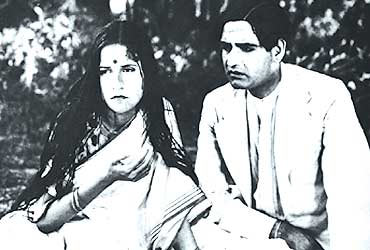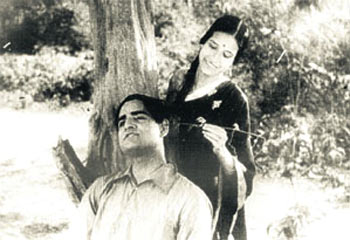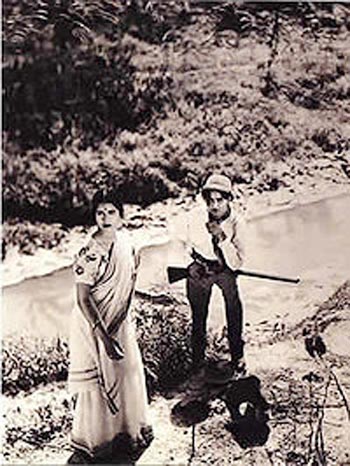 | « Back to article | Print this article |
The man who made Devdas popular
We've seen Devdas in all colours.
But we barely know the actor who first brought Saratchandra Chatterjee's famous character to screen.
Actor-singer K L Saigal was the first superstar of the Hindi film industry, and thanks to author Pran Nevile, we get to know more about him in his biography, K L Saigal: The Definitive Biography.
We present an excerpt from the book, about his most popular role in Devdas.
Devdas is remembered as an all-time classic of Indian cinema, which immortalized New Theatres' P C Barua and K L Saigal. It was epoch-making, and marked the blossoming of Indian cinema; with its depiction of feelings and emotions. It brought films closer to real life.
Based on renowned Bengali writer Saratchandra Chatterjee's popular novel which he wrote at the age of seventeen, Devdas was first filmed in 1928, in the silent period, by Naresh Mitra.
P C Barua, a creative genius of his time, best remembered for directing Devdas, raised the level of his film to a solemn tragedy. He introduced a new style of acting, which was natural and unaffected, a departure from the current theatrical mode, and also adopted simple, easy-to-follow dialogues without any literary nuances.
Barua played the title role in the Bengali version and K L Saigal in the Hindi one and both went on to become cult figures.
Devdas is the story of a young man, son of a feudal landlord, who has an abiding love for his childhood playmate Parbati, daughter of his poor neighbour of a lower status and caste. To prevent their growing attachment, Devdas is sent to Calcutta for university education and Parbati is married off to an aged widower.
Devdas returns to the village but is helpless in stopping Parbati's marriage. Devdas goes back to the city, and drowns his sorrows in drink and the company of a singing girl Chandramukhi who gets attached to him. To serve and look after him, she even quits her profession but Devdas' condition deteriorates.
On hearing about his miserable plight, Parbati comes to plead with him to stop drinking but in vain. Rather than follow her advice, he promises Parbati that he would come to see her before he dies. He has consumption, and his decline continues in spite of the devoted care and attention paid to him by Chandramukhi.
In his fragile state of health, and realizing that his end was fast approaching, he embarks on a journey to keep his promise. He travels all night to get to Parbati's village, only to die in front of her home. And Parbati, within the high walls of her home, hears that her Devdas is dead.
Barua's adaptation of the novel in Devdas reflected his own tragic view of a life starved of joy and laughter. His creative passion and technical innovations are revealed in his expert editing for dramatic effect, close-up shots for image construction, and use of sound to suggest telepathic communication between the characters. Equally striking are the emotional patterns built through skilful handling of the visuals like conveying a sentiment or reaction through halting speech and using the intervening pauses during a dialogue for a more telling effect than the spoken word.
Excerpted from KL Saigal: The Definitive Biography by Pran Nevile, Penguin Books India, with the publisher's permission, Rs 299.
'The term 'Devdas' replaced the old 'Majnu''
P C Barua, the intellectual prince from Gauripur, had learnt the art of filmmaking in France. He was not only the creator of Devdas, he was Devdas.
Barua was a handsome young man, with aristocratic grace and charm, and had a deep voice which he used in a low, understated manner to enrich the content of visuals. Other features which distinguished Barua were his tragic and rather solemn intensity, his superb handling of actors, his instinct for detail and his subtle ways of depicting the characters' agony and anguish.
For instance, his shooting of the train journey, portraying Devdas' intense suffering, with sounds from the rail track as the backdrop, was indeed a marvel in cinematic art. Barua achieved great fame, popularity and adulation usually reserved for the stars.
As the most eminent and successful creator of romantic-tragic drama, Barua received fabulous offers from Bombay producers to make Devdas-like films for them in Bombay. He rejected them, saying, 'It is not my field; it is a bazaar.'
His fans' admiration for him could be judged from a letter addressed to him, published in a Calcutta paper, which said: 'We are inclined to include you in the category of the great thinkers of the present day. By producing the immortal Devdas, you opened a new way for the Indian film industry, and since then you are looked on as a great philosopher.'
Devdas can be seen as a film of social protest, against the evils of class and a caste-ridden society. There was some criticism for its highlighting the path of dejection, drink, disease and death, which could have an adverse influence on young minds. But people loved the hero Devdas; the film touched virtually a whole generation. The Devdas syndrome became synonymous with unrequited love.
Barua's Hamlet-like personality and his premature death, like his Hindi-version-hero K L Saigal, through alcoholism, made him an icon of cinematic genius. Just before his death, he is reported to have said, 'Devdas was in me even before I was born, I created it every moment of my life, much before I put it on the screen, it was no more than a mirage, a play of light and shade, and sadder still, it ceased to exist after two hours. Now it's just a myth.'
The powerful appeal of the romantic-tragic hero made Devdas a cult figure. This set the pace for the popularity of the doomed hero on the Indian screen. The term 'Devdas' replaced the old 'Majnu', to symbolize a deeply dejected lover. For lovers, 'Devdasiat' became a fashion which implied a condition to be envied, cultivated and revelled in.
Both Bengali and Hindi versions of Devdas were released in 1935. Though K L Saigal was no match for Barua's attractive appearance and charm, he more than made it up with his enchanting melodies.
The role of Parbati, the heroine, was played by Jamuna in both the Bengali and Hindi versions, while Chandramukhi was enacted by Chandrabati and Rajkumari respectively.
Originally, Barua wanted Kananbala to play the part of Chandramukhi as she had already established her name and fame in Bengali cinema. But as she was bound by her contract with Madan Theatres, she could not accept Barua's offer. The phenomenal success of the film was also attributed to its marvellous music composed by Timir Baran (Hindi) and R C Boral and Pankaj Mullick (Bengali).
'The term 'Devdas' replaced the old 'Majnu''
P C Barua, the intellectual prince from Gauripur, had learnt the art of filmmaking in France. He was not only the creator of Devdas, he was Devdas.
Barua was a handsome young man, with aristocratic grace and charm, and had a deep voice which he used in a low, understated manner to enrich the content of visuals. Other features which distinguished Barua were his tragic and rather solemn intensity, his superb handling of actors, his instinct for detail and his subtle ways of depicting the characters' agony and anguish.
For instance, his shooting of the train journey, portraying Devdas' intense suffering, with sounds from the rail track as the backdrop, was indeed a marvel in cinematic art. Barua achieved great fame, popularity and adulation usually reserved for the stars.
As the most eminent and successful creator of romantic-tragic drama, Barua received fabulous offers from Bombay producers to make Devdas-like films for them in Bombay. He rejected them, saying, 'It is not my field; it is a bazaar.'
His fans' admiration for him could be judged from a letter addressed to him, published in a Calcutta paper, which said: 'We are inclined to include you in the category of the great thinkers of the present day. By producing the immortal Devdas, you opened a new way for the Indian film industry, and since then you are looked on as a great philosopher.'
Devdas can be seen as a film of social protest, against the evils of class and a caste-ridden society. There was some criticism for its highlighting the path of dejection, drink, disease and death, which could have an adverse influence on young minds. But people loved the hero Devdas; the film touched virtually a whole generation. The Devdas syndrome became synonymous with unrequited love.
Barua's Hamlet-like personality and his premature death, like his Hindi-version-hero K L Saigal, through alcoholism, made him an icon of cinematic genius. Just before his death, he is reported to have said, 'Devdas was in me even before I was born, I created it every moment of my life, much before I put it on the screen, it was no more than a mirage, a play of light and shade, and sadder still, it ceased to exist after two hours. Now it's just a myth.'
The powerful appeal of the romantic-tragic hero made Devdas a cult figure. This set the pace for the popularity of the doomed hero on the Indian screen. The term 'Devdas' replaced the old 'Majnu', to symbolize a deeply dejected lover. For lovers, 'Devdasiat' became a fashion which implied a condition to be envied, cultivated and revelled in.
Both Bengali and Hindi versions of Devdas were released in 1935. Though K L Saigal was no match for Barua's attractive appearance and charm, he more than made it up with his enchanting melodies.
The role of Parbati, the heroine, was played by Jamuna in both the Bengali and Hindi versions, while Chandramukhi was enacted by Chandrabati and Rajkumari respectively.
Originally, Barua wanted Kananbala to play the part of Chandramukhi as she had already established her name and fame in Bengali cinema. But as she was bound by her contract with Madan Theatres, she could not accept Barua's offer. The phenomenal success of the film was also attributed to its marvellous music composed by Timir Baran (Hindi) and R C Boral and Pankaj Mullick (Bengali).
'The greatest asset of the film was the golden voice of Saigal'
Apart from his sterling performance as Devdas, which made him Indian cinema's first superstar, Saigal also had a sensational walk-on part in the Bengali version as one of the visitors to Chandramukhi's kotha and sang two Bengali songs Kahare je jodatey chai and Golap hoey uthuk phutey.
Saigal took pains to learn the meaning of each word of the songs and absorbed the mood and ambience of the scenes in which they were to be sung. Sung in a classical style in leisurely fashion, with pauses, the songs in Saigal's voice evoked unique beauty and serenity.
Originally, Pankaj Mullick was scheduled to sing these songs but when he heard the recordings, he felt he could not match the magical spell created by Saigal's voice. This was Saigal's Bengali debut and the New Theatres' controllers of production awaited the author Saratchandra Chatterjee's approval because they apprehended a negative public response to Saigal's imperfect Bengali accent.
When Chatterjee arrived and heard the recording, he was greatly pleased and at once gave his approval by pointing out that non-Bengalis were not barred from visiting the salons of singing girls and Saigal's rendition of the songs was justified in the scene. Later, Saigal acted in several Bengali films of New Theatres.
It was noted in some quarters that the tragic ending in Devdas did not conform to the Indian classical tradition in which there were only happy endings. In Sanskrit dramas there was no room for tragedy, since the Hindu mind treated life as a transitional state. But in the nineteenth century, Western influence had had its impact on Bengali literature and drama, and the element of a tragic ending had been already introduced before Devdas.
Many literary stalwarts and critics consider the tragedy and its portrayal saturated with agony and anguish to be a far greater literary achievement than comedy. The emotional content of the tragedy has a powerful and enduring impact on the audiences and enlightens them about the intensity of human feelings and their meaning in life.
All famous Indian love-legends -- of Laila-Majnu, Heer-Ranjha, SohniMahiwal and Mirza Sahiban -- glorify true love with a tragic end and with the firm belief that the lovers would be united in the next life.
Compared with the Bengali version, the Hindi Devdas, which had a much larger reach all over the subcontinent, was a superhit. The dialogue and lyrics were written by Kidar Sharma, who created an amazing script, infusing its romantic-tragic plot with a revolutionary naturalness of tone.
It was remarked, 'This isn't dialogue, this is the way we talk.' And that was precisely what Barua was looking for.
And, of course, the greatest asset of the film was the golden voice of Saigal, who was already a celebrity with his recent remarkable success as a singer-actor in Chandidas.
'Saigal was the first artiste to sing in a relaxed, natural and intimate style'
Saigal was the first artiste to sing in a relaxed, natural and intimate style and his songs were essentially dialogue in the musical form.
The camera work was done by Bimal Roy, a genius in his own right.
The songs like Balam aao baso mere man mein were on everyone's lips throughout the country and Saigal became a household name and a virtual legend in his own lifetime. The movie itself brought name and fame to everyone, great or small, connected with New Theatres.
Barua was proclaimed a frontrank filmmaker and New Theatres as the leading light of the Indian film industry. Never before had any film won such universal acclaim and achieved such astounding commercial success. It was hailed by the Bombay Chronicle as 'a brilliant contribution to the Indian film industry. One wonders as one sees it, when we shall have such another.'
Hearing Saigal sing Dukh ke ab din bitat nahin, sung in Desh raga in the thumri style, became an addiction for millions of Saigal fans. They would throng to the cinema halls to watch Saigal, with his drooping lock of hair escaping from under the sola hat, carrying a gun and aimlessly wandering in the village outskirts on a hot afternoon looking for birds to shoot.
I vividly recall my college days when boys would not only hum the songs but would memorize the dialogue and enjoy articulating it in friendly circles. For many fans, the most touching and memorable scene was Devdas lying in despair and singing, or rather whispering, in perfect cadence Piya bin nahin avat chain (sung in Raga Piloo), made famous by the great maestro Abdul Karim Khan.
Spoken one word at a time, Piya bin connects into one piece and turns into a fantastic melody which has a mystifying impact on the listener. It is said that when Khan Sahib was told about this, he went to the cinema for the first time in his life and saw Devdas.
Saigal's marvellous rendition of his thumri Piya bin brought tears to his eyes and Khan Sahib wept like a child. The other Devdas songs as sung by Saigal are still heard on the radio, but this one was never recorded on a disc and can be heard only by watching the film.



